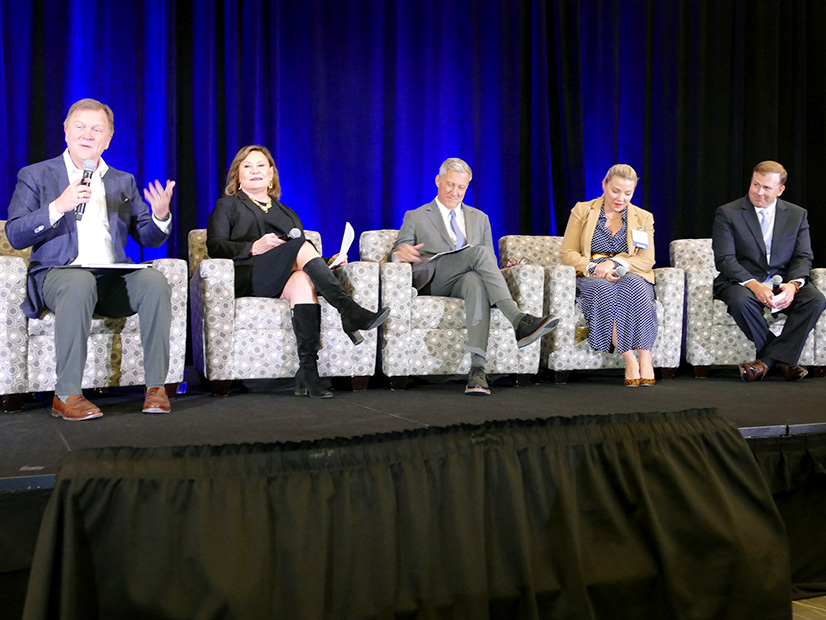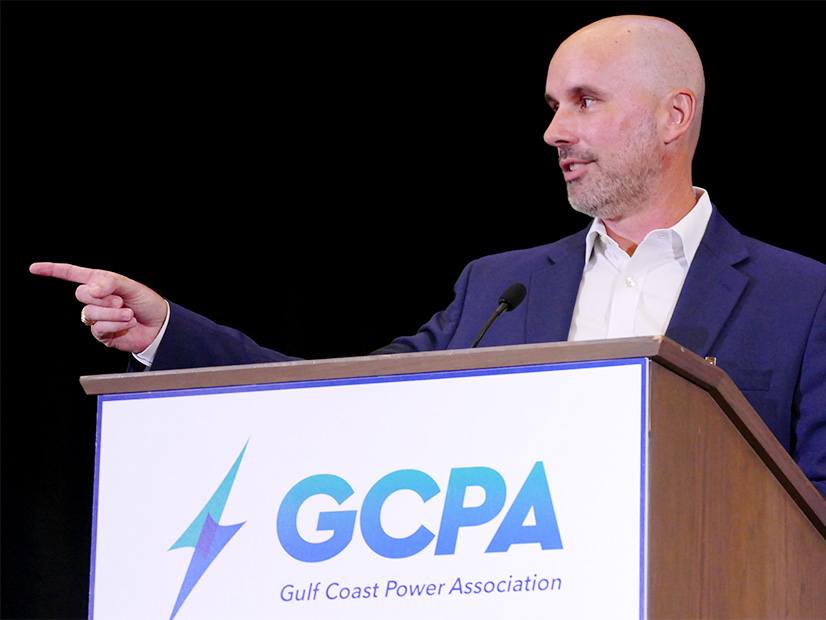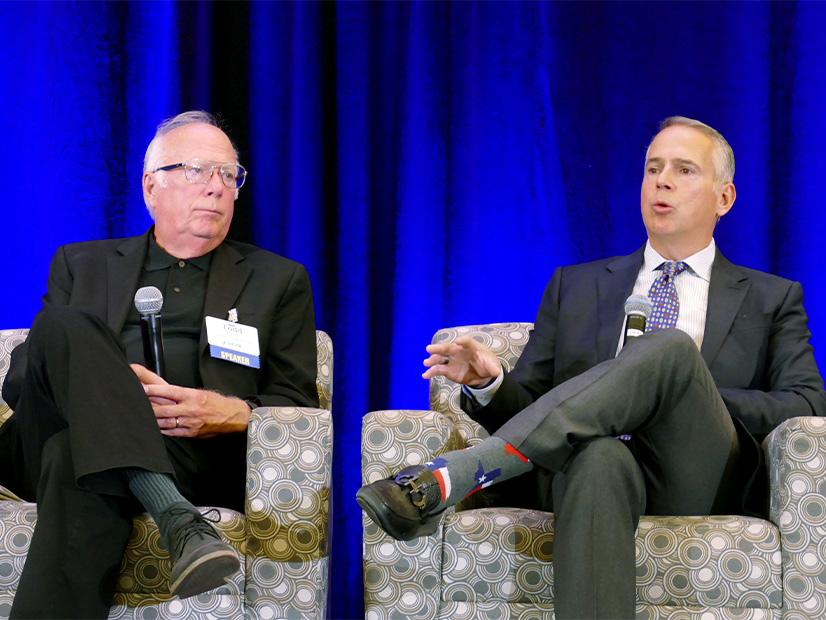
ERCOT CEO, State Rep Preview 2025 Texas Legislative Session
AUSTIN, Texas — The Gulf Coast Power Association again reported a record attendance — just over 800 — for its annual Fall Conference held Sept. 30 to Oct. 2, with discussions on the industry’s future, emerging grid technologies and Texas’ 2025 legislative session.
ERCOT CEO Pablo Vegas and state Rep. Todd Hunter (R) — chair of the House State Affairs Committee, which oversees the Texas grid — kicked off the conference with a fireside chat that included their expectations on the 89th Texas Legislature, which convenes Jan. 14.
“Here’s the bottom line for all the questions I get every place I go: labor, water, power. I bet I get contacted every two to three weeks by new groups coming to look at Texas,” said Hunter, often referred to as “The Man in Black” around the Texas Capitol for his wardrobe choice. “So what’s on the legislative agenda? One, I think you will see a push by the legislature to do what we can to increase power resources. Texas, I think, is the fastest growing state. The demands are huge. And what does that mean? Water, labor and power.
“The message from me: What’s on the plate is to do everything we can meet the needs.”
Vegas said ERCOT works “incredibly closely” with Hunter’s committee and that there isn’t a “big gap” operationally between what the grid operator has and what it will need for the next few years. The sessions that followed Winter Storm Uri of February 2021, he said, “have set us up for the growth trajectory that’s in front of us.”
“One thing that maybe we’ll spend a little bit of time on is talking about how to best manage the influx of different types of large loads that are coming to Texas,” Vegas said. “That’s something that is an evolving and changing dynamic. … Whether it’s data centers; whether it’s hydrogen developers; whether it’s the electrification that we’re seeing out in the Permian [Basin], there’s going to be a wide variety of opportunities to work with these customer groups to find ways to help them grow reliably and rapidly, because Texas does have one of the most fertile environments for economic growth. I think we’re going to be really well positioned for a constructive legislative session.”
Moderator Barbara Clemenhagen, GCPA executive director, asked whether ERCOT will continue its post-Uri conservative operations posture in which it sets aside several thousand megawatts each day to respond to tight situations. Vegas responded that as an “energy island,” the grid operator can’t lean on its neighbors to protect a “flagship competitive market that is studied and looked at very closely around the world.”
“This competitive market works, and I believe that it can work in the changing environment that’s coming our way,” Vegas said. “We have one of the most dynamic set of resources that are providing energy; that can come and go and fluctuate their intermittency on the wind and solar side. We need to have a lot of these reserve resources to be able to manage that because we can’t lean on anyone else. This is what we have to do in order to ensure we can be reliable on a regular basis. I don’t believe consumers or stakeholders are comfortable with living on the edge of a grid that could be an emergency condition on a regular basis.”
ERCOT Deals with Uncertainty
ERCOT’s Dan Woodfin, vice president of system operations, said the pace of change in generator types has been so “tremendous” that the ISO’s operators are having to learn a new system every six months.
“Operators like to have rules of thumb about how they operate,” he said. “A couple of years ago, we had a lot of wind and a little bit of solar. Last summer, we had more solar and a few batteries. And this year we have more solar and more batteries. And next year, we’re going to have twice as much solar, potentially, and a lot more batteries. That means every six months or so, we throw away all our rules of thumb and we’re operating a new system.”
Woodfin said four issues must be considered in adapting the grid to new technologies: adequacy, uncertainty, variability and stability.
“If you’re involved in the ERCOT stakeholder process, you will recognize those things as being the underlying factors behind most of the major debates that have gone on in the last year or so,” he said. “Managing the sunrise and sunset ramps is going to become increasingly critical. Now, the increasing number of batteries help manage other resources’ variability, but then we have to make sure we’re not overly depending on them beyond their inherent limited duration.
“There’s also the managing of the uncertainty because some of that we can predict. I’m pretty good at predicting when the sun’s going to come up and when the sun’s going to go down every day,” Woodfin continued. “But as we get more wind and solar, even if we’re driving down the percentage error in terms of our forecast, the errors continue to grow with the additional installed capacity. So there’s just a lot of variability and uncertainty growing.”
PUC Exes Praise SPP
A panel of former Texas regulatory commissioners shared their perspectives on recent shifts in energy policy and offered their thoughts on improving the stakeholder process and communications between ERCOT’s Technical Advisory Committee and the Board of Directors.
“What’s the right way to kind of think about efficient, inclusive and successful [relationships]?” asked Pat Wood III (1995-2001). He noted recent comments by Public Utility Commission Chair Thomas Gleeson that the interaction between the board and TAC “did not work” for him. (See “Members Discuss Stakeholder Process,” ERCOT Technical Advisory Committee Briefs: Sept. 19, 2024.)
“There’s a disconnect, seemingly, between all these arguments that are happening at TAC and what the board eventually deliberates on,” said Will McAdams (2021-2023). “But I believe we don’t need to reinvent the wheel. Other ISOs have crossed this Rubicon before.”
McAdams offered SPP’s Members Committee as an example. The 23-person committee, comprising several different stakeholder segments, debates issues and provides an advisory vote for the board before the directors cast their ballots.
“The Members Committee is a great tool … and none of this requires statutes, by the way,” McAdams said. “I think it could be self-adopted, but … some type of equivalent organization that may not be empowered to have a binding vote … where the board will see the arguments from the industrial segment; the industry segment; the utility segment. They’ll know exactly what they’re getting into with their vote.”
“I 100% agree with that,” Pedernales Electric Cooperative CEO Julie Parsley (2002-2008) said as Brandy Marty Marquez (2013-2018) nodded her head in agreement.
“SPP has been great because they sit at the table; they argue,” Parsley said. “They vote, right? But they’re not the controlling vote. They just vote, and then the independent board members vote. [The members are] in front of them. They’re not off in some committee room at TAC, so they hear it all, and it’s really great.”
Marquez, McAdams and Parsley all represented Texas on SPP’s Regional State Committee.
DOE’s Biddle Spotlights Clean Energy
Bearing what she called “the longest title in the world,” Leslie Biddle — the U.S. Department of Energy’s deputy under secretary for commercialization and finance — issued a call to action for utilities, regulators and the rest of the industry to “rethink our go-to solutions” for adding new generation.
“So how do we do that in a way that addresses the baseload needs?” she asked her audience. “I’m so excited to be here because we do also need to change the culture; we need to use things differently than we have in the last couple decades. For a few decades now, we’ve been using the same labor to build centralized generation and associated transmission and distribution to meet those long-term human needs. It worked … but we haven’t really had to innovate, and we haven’t had to adopt new ways of working, and we will.”
Case in point: DOE’s latest in a series of liftoffs reports, Pathways to Commercial Liftoff. Thanks to the Infrastructure Investment and Jobs Act and the Inflation Reduction Act, the department is positioned to invest billions of dollars in large-scale demonstration and deployment of clean energy technologies it says will be needed to meet rising demand.
Biddle pointed to a slide that listed more than $6 billion in investment for two dozen awards for projects in Texas and Louisiana. They included $1.2 billion to X-energy to develop gas-cooled reactors and another $1.2 billion for a hydrogen hub involving Chevron, ExxonMobil and Air Liquide, among others.
“We expect this all to be built in the next four years,” she said. “Our capital goes in currently for the development stage.”
DOE says it expects 15 to 20% growth in demand over the next decade and for it to double by 2050, driven by economic development and electrification.
“It’d be hard to say that we aren’t surprised about the electricity demand growth over the next decade, when you’re telling everyone that they should electrify. That’s what happens,” Biddle said. “From our perspective, growth is good. It means that we’re bringing in more manufacturing jobs, and we’re expanding our leadership and innovation and expanding artificial intelligence and expanding access to more efficient clean growth in America. It will require a change in the way we invest and manage our system. Fortunately, we have the technologies and the solutions we need to meet the growing demand.”
AI as Savior for Clean Energy?
DOE could find help in reaching its net-zero-emissions goals from an unlikely source, according to several panelists discussing artificial intelligence.
“I’m going to say something slightly controversial, but I feel that AI and the computing power and all of that, even though in some ways it’s consuming more … we need AI to get us to net zero because of the sort of second-by-second optimality that we need,” said Erin Boyd, chief digital commercial transformation officer for AES. “All of the data goes into getting more out of our assets and finding better locations and managing demand and supply just down to that sort of microsecond.
“Even though everybody says, ‘Oh, AI is driving up energy demand,’ it’s an interesting problem where I’m not so convinced yet that that’s the case. I believe that AI is actually what’s going to get us to net zero and a situation where we’re actually consuming less, but also consuming energy that’s uncertain; that’s fickle, that you know can’t be managed.”
“I’m also very upbeat about the potential for AI,” said Venkat Tirupati, ERCOT’s vice president of DevOps and grid transformation. “I look at it from two different angles. The first angle is just on grid operations and market operations. There are definitely things that will help us to be more efficient to run markets very well. But if I look at ERCOT as an enterprise, there are a lot of productivity gains that we could get by just embracing AI into the everyday.”
PUC’s Roth Gets Award
The GCPA honored the PUC’s Werner Roth with its emPOWERing Young Professional Award, presented annually to individuals under the age of 40 who have demonstrated excellence in the electric power industry, made unique contributions to the power market’s success, and served as a role model and leader for others.
Roth, a senior market economist in the market analysis division, has worked at the commission for more than 10 years. He holds bachelor’s and master’s degrees in economics and another bachelor’s degree in chemical engineering.
“I have often wondered how a young graduate without experience in the electric markets could develop such deep and wide skills for power markets,” said Harika Basaran, the division’s director. “Then I realized that he did most of it on his own initiative.”
Roth thanked the commission’s leadership for allowing him to “lean in on a lot of the projects that have focused on a lot of issues in the ERCOT process and, more importantly, have enabled staff to [provide] perspective on those







